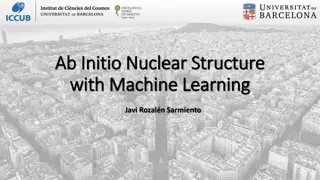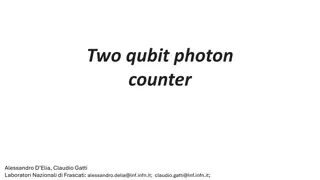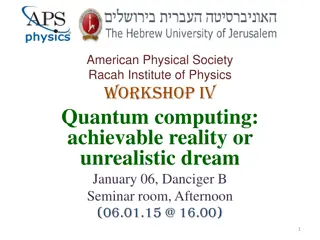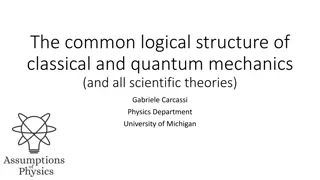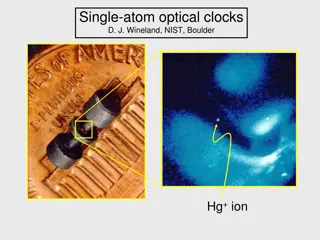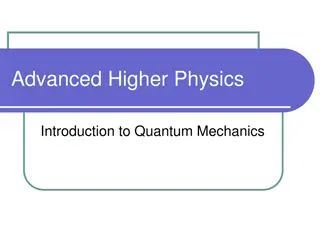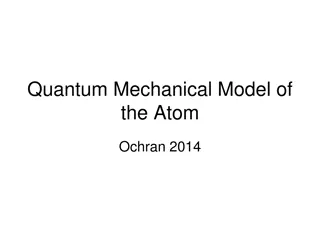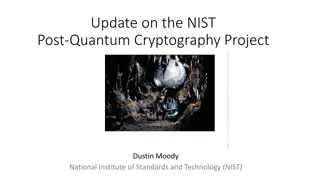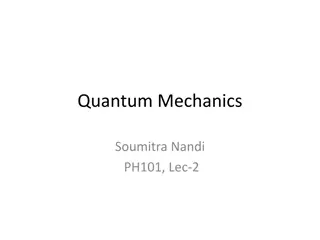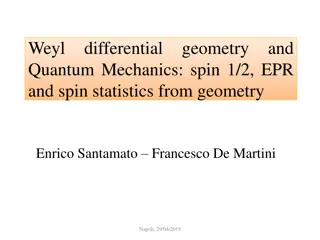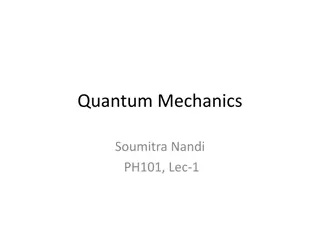Understanding Quantum Mechanics in Atomic Structure
Exploring the connection between quantum mechanics and the fundamental elements of the periodic table, this material delves into the Schrödinger equation, quantization of angular momentum and electron spin, and the implications on atomic structure. The content covers writing the Schrödinger equation for three-dimensional problems, finding wave functions for particles in containers, and understanding the quantum-mechanical descriptions of atoms. Additionally, it discusses the impact of external magnetic fields on electron motion, the exclusion principle in many-electron atoms, and how x-ray spectra reveal atomic structures.
Download Presentation

Please find below an Image/Link to download the presentation.
The content on the website is provided AS IS for your information and personal use only. It may not be sold, licensed, or shared on other websites without obtaining consent from the author. Download presentation by click this link. If you encounter any issues during the download, it is possible that the publisher has removed the file from their server.
E N D
Presentation Transcript
PHYS274 Atomic Structure I Review: What is shown here ? Announcements 3D Schrodinger Equation Atomic Structure (Connection of QM and the fundamental elements and the periodic table !) 1
Announcements Next Midterm: Monday November 13th will cover waves as particles (Chap 38), particles as waves (Chap 39) and quantum mechanics (Chap 40). Posted a practice exam for midterm II on the course website. Updated the Mastering Physics homework assignments up to the end of the semester
Goals for Chapter 41 (Atomic Structure) To write the Schr dinger equation for a three-dimensional problem To learn how to find the wave functions and energies for a particle in a three-dimensional box To examine the full quantum-mechanical description of the hydrogen atom To learn about quantization of orbital angular momentum; will examine how an external magnetic field affects the orbital motion of an atom s electrons To learn about the intrinsic angular momentum (spin) of the electron To understand how the exclusion principle affects the structure of many-electron atoms To study how the x-ray spectra of atoms indicate the structure of these atoms 3
What is shown here ? Ans: Yes. Quantization of angular momentum and spin plays a critical role. Is this connected to quantum mechanics ? 4
Here is the big picture idea Note that this is the Schrodinger eqn in 3- dimensions Now let s work on the details
Introduction The Bohr model, in which an atom s electrons orbit its nucleus like planets around the sun, is inconsistent with the wave nature of matter. A correct treatment uses quantum mechanics and the three- dimensional Schr dinger equation. To describe atoms with more than one electron, we also need to understand electron spin and the Pauli exclusion principle. These ideas explain why atoms that differ by just one electron (like lithium with three electrons per atom and helium with two electrons per atom) can be dramatically different in their chemistry. Li He 6
The Schrdinger equation in 3-D Electrons in an atom can move in all three dimensions of space. If a particle of mass m moves in the presence of a potential energy function U(x, y, z), the Schr dinger equation for the particle s wave function (x, y, z, t) is This is a direct extension of the one-dimensional Schr dinger equation. 7
The Schrdinger equation in 3-D: Stationary states If a particle of mass m has a definite energy E, its wave function (x, y, z, t) is a product of a time-independent wave function (x, y, z) and a factor that depends on time but not position. Then the probability distribution function | (x, y, z, t)|2 = | (x, y, z)|2 does not depend on time (stationary states). ( ) ( , , , = x y z t x y z e ) / iEt , , The function (x, y, z) obeys the time-independent Schr dinger equation in three dimensions: 8
Particle in a three-dimensional box For a particle enclosed in a cubical box with sides of length L (see Figure below), three quantum numbers nX, nY, and nZ label the stationary states (states of definite energy). The three states shown here are degenerate: Although they have different values of nX, nY, and nZ, they have the same energy E. 9
What does degenerate mean ? adjective: degenerate d jen( )r t/ 1. having lost the physical, mental, or moral qualities considered normal and desirable; showing evidence of decline. Examples: "a degenerate form of a higher civilization synonyms: debased, degraded, corrupt, impure; formal vitiated e.g. "a degenerate form of classicism" In this case, degenerate means degenerate in energy or having the same energy
Particle in a 3-D box: Separation of Variables Important technique for partial differential equations. y(x,y,z)= X(x)Y(y)Z(z) Separation of variables . Now insert in here 11
Particle in a 3-D box: Separation of Variables (contd) Now divide by X(x)Y(y)Z(z) 12
Particle in a 3-D box:Boundary conditions/results On the walls, X, Y, Z must be zero X(x)=0 at x=0 and x=L; Y(y)=0 at y=0 and y=L; Z(z)=0 at z=0 and z=L Xnx(x)= CXsin(nXpx Yny(y)= CYsin(nYpy Znz(z)= CZsin(nZpz )sin(nYpy L ) L ) ) L L ynx,ny,nz(x,y,z)= Csin(nXpx )sin(nZpz ) L L (nx=1,2,3...;ny=1,2,3...;nZ=1,2,3...) 13
Application of this mathematics for EM waves Standing EM waves inside a rectangular microwave oven On the walls, X, Y, Z must be zero X(x)=0 at x=0 and x=L; Y(y)=0 at y=0 and y=L; Z(z)=0 at z=0 and z=L ynx,ny,nz(x,yz)= Csin(nXpx )sin(nYpy )sin(nZpz ) L L L (nx=1,2,3...;ny=1,2,3...;nZ=1,2,3...) Question: Why do the n s start from one ? Is nx=0 a solution ? 14
Clicker question on 3-D particle in a box A particle in a cubical box is in a state of definite energy. The probability distribution function for this state A. oscillates in time, with a frequency that depends on the size of the box. B. oscillates in time, with a frequency that does not depend on the size of the box. C. varies with time, but the variation is not a simple oscillation. D. does not vary with time. E. answer depends on the particular state of definite energy 15
Clicker question 3-D particle in a box A particle in a cubical box is in a state of definite energy. The probability distribution function for this state A. oscillates in time, with a frequency that depends on the size of the box. B. oscillates in time, with a frequency that does not depend on the size of the box. C. varies with time, but the variation is not a simple oscillation. D. does not vary with time. E. answer depends on the particular state of definite energy So yy*=|y(x,y,z)|2 16
Clicker question 3-D particle in a box A particle is in a cubical box with sides at x = 0, x = L, y = 0, y = L, z = 0, and z = L. When the particle is in the state nX = 2, nY = 1, nZ = 1, at which positions is there zero probability of finding the particle? A. on the plane x = L/2 B. on the plane y = L/2 C. on the plane z = L/2 D. more than one of A., B., and C. E. none of A., B., or C. 17
Clicker question 3-D particle in a box A particle is in a cubical box with sides at x = 0, x = L, y = 0, y = L, z = 0, and z = L. When the particle is in the state nX = 2, nY = 1, nZ = 1, at which positions is there zero probability of finding the particle? A. on the plane x = L/2 B. on the plane y = L/2 C. on the plane z = L/2 D. more than one of A., B., and C. E. none of A., B., or C. ynx,ny,nz(x,yz)= Csin(nXpx )sin(nYpy )sin(nZpz ) L L L (nx=1,2,3...;ny=1,2,3...;nZ=1,2,3...) 18
The hydrogen atom: Quantum numbers The Schr dinger equation for the hydrogen atom is best solved using coordinates (r, , ) rather than (x, y, z) (see Figure at right). The stationary states are labeled by three quantum numbers: n (which describes the energy), l (which describes orbital angular momentum), and ml (which describes the z-component of orbital angular momentum). 19
The hydrogen atom: Schrodinger Equation Use this potential in the Schrodinger Equation -1 4pe0 e2 r U(r)= Use the separation of variables technique and spherical coordinates y(r,q,f)= R(r)Q(q)F(f) 20
The hydrogen atom: 3-D Schrodinger Equation y(r,q,f)= R(r)Q(q)F(f) 21
The hydrogen atom: Results with Schrodinger En=-13.6eV This result agrees with the Bohr model ! n2 Here l=0,1,2, .n-1 This result does not agree with the Bohr model. Question: Why ? What happens for n =1 ? Here m=0, 1, 2, . l The Bohr model does not include this part at all. 22
Some common notation The letters s, p, d, (f) are used to refer to the values of the orbital angular momentum associated with a wavefunction. Conventionally s means l=0, p means l=1, d means l=2 and occasionally f (l=3) are often used. e.g. Let s look at the 1s wavefunction of the hydrogen atom i.e. the n=1, l=1 wavefunction.
Q29.1 A quantum-mechanical system initially in its ground level absorbs a photon and ends up in its first excited state. The system then absorbs a second photon and ends up in the second excited state. For which of the following systems does the second photon have a longer wavelength than the first one ? A) A harmonic oscillator B) A hydrogen atom C) A particle in a box D) Impossible for any system by the Heisenberg uncertainty principle 24
Q29.1 A quantum-mechanical system initially in its ground level absorbs a photon and ends up in its first excited state. The system then absorbs a second photon and ends up in the second excited state. For which of the following systems does the second photon have a longer wavelength than the first one ? A) A harmonic oscillator B) A hydrogen atom C) A particle in a box D) Impossible for any system by the Heisenberg uncertainty principle 25
Q29.1 A quantum-mechanical system initially in its ground level absorbs a photon and ends up in its first excited state. The system then absorbs a second photon and ends up in the second excited state. For which of the following systems does the second photon have a longer wavelength than the first one ? A) A harmonic oscillator B) A hydrogen atom C) A particle in a box D) Impossible for any system by the Heisenberg uncertainty principle 26
Q29.1 A quantum-mechanical system initially in its ground level absorbs a photon and ends up in its first excited state. The system then absorbs a second photon and ends up in the second excited state. For which of the following systems does the second photon have a longer wavelength than the first one ? A) A harmonic oscillator B) A hydrogen atom C) A particle in a box D) Impossible for any system by the Heisenberg uncertainty principle 27
The hydrogen atom: Results En=-13.6eV This result agrees with the Bohr model ! n2 Here l=0,1,2, .n-1 This result does not agree with the Bohr model. Question: Why ? What happens for n =1 ? Here m=0, 1, 2, . l The Bohr model does not include this part at all. 28
Q29.2 29
Q29.2 30
Particle in a three-dimensional box For a particle enclosed in a cubical box with sides of length L (see Figure below), three quantum numbers nX, nY, and nZ label the stationary states (states of definite energy). The three states shown here are degenerate: Although they have different values of nX, nY, and nZ, they have the same energy E. 31
For next time Atomic concepts Read material in advance Review spherical coordinates, angular momentum Read about spin. 32

 undefined
undefined










